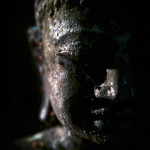Jack Kornfield provides the reader with an understanding and instruction to metta – loving kindness meditation.
May I be filled with loving-kindness “I am larger, better than I thought; I did not know I held so much goodness.” – Walt Whitman. More…
Jack Kornfield provides the reader with an understanding and instruction to metta – loving kindness meditation.
May I be filled with loving-kindness “I am larger, better than I thought; I did not know I held so much goodness.” – Walt Whitman. More…
Opening the heart begins by opening to a lifetime’s accumulation of unacknowledged sorrow, both our personal sorrows and the universal sorrows of warfare, hunger, old age, illness, and death. At times we may experience this sorrow physically, as contractions and barriers around our heart, but more often we feel the depth of our wounds, our abandonment, our pain, as unshed tears. The Buddhists describe this as an ocean of human tears larger than the four great oceans.
As we develop a meditative attention, the heart presents itself naturally for healing. The grief we have carried for so long, from pains and dashed expectations and hopes, arises. We grieve for our past traumas and present fears, for all of the feelings we never dared experience consciously. Whatever shame or unworthiness we have within us arises—much of our early childhood pain is stored in the heart. READ MORE…
“An award-winning journalist vividly reports her two-year, 60,000-mile global odyssey in the company of exceptional women who choose to dedicate their lives to Buddhism.
In 2011, Christine Toomey met an unforgettable group of Tibetan Buddhist nuns. After hearing their stories—of prison, extreme hardship, and ultimately fleeing across the Himalayas into exile—she resolved to learn more about the private, courageous women of Buddhism: who they are, their experience of suffering, what motivates them to seek enlightenment, and what stands in their way. Toomey’s quest took on even greater urgency with the sudden deaths of her father and then her mother, and her own search for healing wisdom in the aftermath of loss.
In Search of Buddha’s Daughters introduces us to women from around the world—Nepal, India, Burma, and Japan, as well as the US, the UK, and France—who have come to the ordained life from every faith and career: a former policewoman, a princess, a Bollywood star, and a concert violinist. Toomey meets a Harvard graduate who sometimes breaks into hip-hop moves after meditating, a Japanese nun who has written bestselling erotica, and a Nepalese order of nuns who practice kung fu for spiritual and physical empowerment.
Through insightful conversations with over thirty women, Toomey investigates Buddhism as an antidote to the problems of life in the twenty-first century, and considers the status of women today—worldwide, and within one of our oldest wisdom traditions. “In a world numbed by the amount of attention paid to violence, terrorism, and political and religious power struggles,” she writes, “I find it profoundly refreshing to come across women whose lives are dedicated to nurturing the opposite.” Courtesy of Amazon.com
Read on for an excerpt of a moving book that explores the life stories of highly spiritual Buddhist nuns and how they restored a war correspondent’s faith in Humanity,
Thich Nhat Hanh explains that sangha is more than a community, it’s a deep spiritual practice.
Reprinted from Friends on the Path: Living Spiritual Communities (2002) by Thich Nhat Hanh with permission of Parallax Press, Berkeley, California, www.parallax.org.
“Love is our true nature, but it is often covered over by a protective layer of fear. Buddhist practices unearth the gold beneath the clay, and return us to our natural goodness. The Buddhist path also uses systematic trainings to cultivate this love. These trainings are found throughout the Buddhist world. They strengthen our capacity for love, compassion, joy and peace. The practices that develop these qualities combine repeated thoughts, visualization and feelings.”
Read entire article, an excerpt taken from Jack Kornfield’s book “The Wise Heart.”
“To commit to another person is to embark on an adventurous journey,” says Thich Nhat Hanh. “You must be wise and patient to keep your love alive so it will last for a long time.” In his introduction to the book, Love’s Garden: A Guide to Mindful Relationships, Thich Nhat Hanh shows us how we can use loving relationships to cultivate the seeds of buddhahood inside us.
T he Buddha said, “I teach one thing and one thing only: suffering and the end of suffering.” Ten teachers — including Pema Chödrön, Norman Fischer, and Sharon Salzberg — explain why that isn’t a condemnation, but a joyous opportunity. Read on.
he Buddha said, “I teach one thing and one thing only: suffering and the end of suffering.” Ten teachers — including Pema Chödrön, Norman Fischer, and Sharon Salzberg — explain why that isn’t a condemnation, but a joyous opportunity. Read on.
 Wanting What’s Right
Wanting What’s RightFrom the perspective of Buddhist psychology, compassion is natural. It derives from our interconnection, which Buddhism calls “interdependence.” This can be readily seen in the physical world. In the womb, every child is interdependent with its mother’s body. If either of them is sick, the other is affected. In the same way we are interdependent with the body of the earth. The minerals of the soil make up our wheat and bones, the storm clouds become our drinks and our blood, the oxygen from the trees and forests breathe with us, interdependent with our own life. Read on. This excerpt is taken from the book, The Wise Heart.
The Spirit Rock Mediation Center in Woodacre, California shared a lovely post this December:
“During this season of gift giving, reflect on how you might practice generosity throughout the year. There are many ways to cultivate an attitude of generosity in daily life.